Home - Fundamentals of Rhythm Table of Contents
Lesson 20: Odd Meters with the Eighth Note Equal to One Beat
Lesson 20 combines the information introduced in Lesson 13 (time signatures with the eighth note equal to one beat) and Lesson 19 (odd meters). This lesson features odd meters with the eighth note equal to one beat.
5/8 Time Signature
As we learned in Lesson 19, odd meter measures are subdivided into beat patterns that make them easier to count. That is also true of odd meter measures with the eighth note equal to one beat. In 5/8, there are two possible beat patterns. In the examples below, the top line of numbers indicates the beat in the measure, and the bottom line in italics represents the subdivision of the measure into smaller groupings of beats.
2 beats + 3 beats in each measure
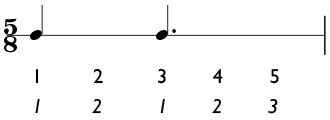
3 beats + 2 beats for each measure
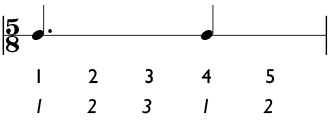
7/8 Time Signature
In 7/8, there are three possible beat patterns:
2 beats + 2 beats + 3 beats in each measure
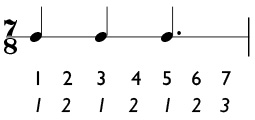
3 beats + 2 beats + 2 beats in each measure
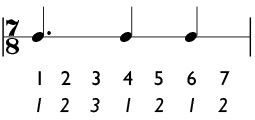
2 beats + 3 beats + 2 beats in each measure
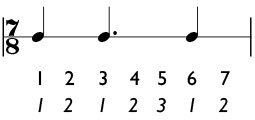
Counting the beats in this manner may be confusing at first because you will count the beat “one” multiple times in a measure. For example, if you are in 5/8 and the subdivision equals 2 + 3 beats, you will count “one two one two three.” You will say the word “one” on the first beat and the third beat of the measure. The key to performing these rhythms successfully is to repeat the patterns many times at an effortless tempo. Doing so will help you to feel the subdivision of each measure, allowing you to become more comfortable with the beat patterns that occur within each measure.
Since the eighth note is equal to the beat, the sixteenth note is equal to half a beat, and the beat will be subdivided accordingly.

 Lesson 20 Practice Suggestions
Lesson 20 Practice Suggestions
Learn how to play shorter note values like 32nd and 64th notes in Lesson 21.
Write your own rhythms and music compositions! Get free blank staff paper at www.music-paper.com.






Get the Book
Fundamentals of Rhythm book
If you would like all of this information in book format so that you can put it on your music stand and practice it wherever you go, get The Fundamentals of Rhythm, by Kyle Coughlin. The book includes all of the lesson information and practice exercises found on the website.
Use MetronomeBot for a fun online metronome!
The online metronome that counts the beat, subdivides, and offers encouraging practice tips.
If you like this site, please share it with others!


Like Kyle Coughlin Music on Facebook
Follow Kyle Coughlin Music on Twitter